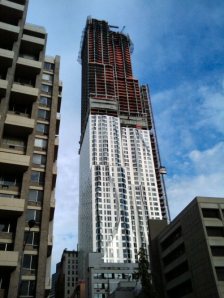 Much as we like to credit a building solely to its “starchitect” — Frank Gehry, Norman Foster, Renzo Piano, etc. — a work of architecture is never the work of one man. It’s the product of a complex, multilayered, multifaceted team of designers, drafters, engineers, contractors, developers, site planners, surveyors, project managers, attorneys, financiers, construction workers, manufacturers, inspectors, client reps, graphic designers, IT technicians and, yes, marketers.
Much as we like to credit a building solely to its “starchitect” — Frank Gehry, Norman Foster, Renzo Piano, etc. — a work of architecture is never the work of one man. It’s the product of a complex, multilayered, multifaceted team of designers, drafters, engineers, contractors, developers, site planners, surveyors, project managers, attorneys, financiers, construction workers, manufacturers, inspectors, client reps, graphic designers, IT technicians and, yes, marketers.
(Did I miss anybody?)
The same goes for project proposals. I just read an interesting piece about the importance of teamwork in proposal production on LinkedIn’s Proposal Development and Writing Secrets group page. Though intended to promote the author’s proposal streamlining and price quotation service, this piece has many good pointers on how to put several heads together to craft and draft a proposal so all stakeholders in the project get in their two cents’ worth. This yields a more professional proposal than if they dumped the whole thing in one person’s lap.
For starters:
 • Select, collect. In a firm meeting or a special proposal powwow, determine up front who all the project’s players will be. Then make up a top-down chart of this project team in a “family tree” format, from principal to project manager to associates to assistants.
• Select, collect. In a firm meeting or a special proposal powwow, determine up front who all the project’s players will be. Then make up a top-down chart of this project team in a “family tree” format, from principal to project manager to associates to assistants.
This will clarify the who, what, when, where and why of each player’s role in the whole. Which in turn will make it easier for each to contribute key content to the proposal in a more structured way.
• Appoint a point. To give credence to the project in the client’s eyes, make the project manager the client’s main point of contact. This way the team’s channel of client communication can consistently come from one point person, rather than a confused cluster of contradictory chatter coming from one member one day and another the next.
 • Collaborate, communicate. For a more fleshed-out proposal with input from all sides, the PM should contact the project team several times to continually get their insights and input prior to, and in the course of, the proposal writing process.
• Collaborate, communicate. For a more fleshed-out proposal with input from all sides, the PM should contact the project team several times to continually get their insights and input prior to, and in the course of, the proposal writing process.
• Retrieve, receive. The PM might begin by sending a group e-mail out to the team with as complete information about the potential client as can be gathered from the Internet, newspapers and library research: the client’s website, LinkedIn and Wikipedia profiles, Twitter and Facebook info, YouTube videos, news coverage, ratings on NASDAQ, Moody’s, Standard & Poor, Dun & Bradstreet, etc.
In this e-mail the PM should ask all team members to e-mail back any additional info about the client and/or its industry they can dig up, and any questions they have about the project. This will prompt the PM to think of more questions to extract more specifics from the client about the project requirements.
• Drill, distill. The PM then interrogates the client with this comprehensive list of questions, allowing the client’s answers to provoke further questions about the project’s technical details and overall aims. Once satisfied with the resultant information, the PM synthesizes it into a bullet-point list of the client’s project requirements and needs to make it easier for the team to peruse and ponder.
 • Brainstorm, form. Based on this point list that arose from their questions, the proposal team has meetings of the minds to form thoughtful solutions to the client’s project demands. More heads involved mean more issues examined, hence a broader, deeper project proposal.
• Brainstorm, form. Based on this point list that arose from their questions, the proposal team has meetings of the minds to form thoughtful solutions to the client’s project demands. More heads involved mean more issues examined, hence a broader, deeper project proposal.
These issues should include:
- How will our service benefit the client, business-wise?
- How will it benefit the users or occupants of the building, in terms of personal well-being and space efficiency?
- What will be the project’s long-term value to the client and generations of users, occupants and/or customers?
- Is our proposal convincing, compelling, competitive?
- How should graphics and images be arranged with texts to communicate our project aims more powerfully in the proposal?
- Are we really addressing the client’s needs, or just trumpeting our track record?
- How can we put our track record to use to meet the client’s specific architectural, social, environmental, economic and civic requirements for this project?
- How will our service qualify the structure for LEED certification?
- What level of LEED certification are we aiming for (silver, gold, platinum)?
- What specific sustainable building materials, cosmetics, construction techniques, material recycling plans, etc., that would make us eligible for LEED certification, should be mentioned in the proposal?
- How could BIM, Revit, etc., be employed to ferret out more specific details of the construction process and product to include in the proposal?
The team as a group should ask the right questions and come up with the right answers to make the proposal client-centric, not egocentric. Thus the client becomes the true architect of the project by dictating the design s/he desires.
 • Stimulate, formulate. E-mail is no substitute for the face-to- face team meetings that stimulate the open discussion needed to formulate not only specific solutions to the client’s project problems, but also collective action plans for preparing the proposal accordingly.
• Stimulate, formulate. E-mail is no substitute for the face-to- face team meetings that stimulate the open discussion needed to formulate not only specific solutions to the client’s project problems, but also collective action plans for preparing the proposal accordingly.
In-the-flesh meetings also prompt unasked questions that raise unresolved issues about unexplained details that could affect the project’s progress and viability. Furthermore, these get-togethers reaffirm the camaraderie and common bond among the team that is essential to both proposal and project success.
• Involve, resolve. It’s also important to involve in the proposal development process the subcontractors, consultants, designers, landscapers, engineers, and anyone else that would be involved in the project itself. This way, each party would get a sense of how the others functioned in the project process so that conflicts within the team could be resolved faster and no one would feel “left out” by not being informed of what was going on every step of the way. And this team spirit would be reflected in the proposal, presenting the project as a collaborative effort, not a soup of supers and subs.
 • Glean, clean. Notwithstanding that collaborative effort, the writing process demands leadership from the proposal manager, coordinator or writer, as marketer Michael Sweeney deftly describes it in his blog, The Design Marketer’s Workstation.
• Glean, clean. Notwithstanding that collaborative effort, the writing process demands leadership from the proposal manager, coordinator or writer, as marketer Michael Sweeney deftly describes it in his blog, The Design Marketer’s Workstation.
This person must receive all e-mails and attend all meetings of the proposal team, take rigorous notes all along, and play journalist, even detective or cross-examiner, in probing the PM and others with additional questions to clear up confusion or glean missing info. Then s/he can synthesize all salient points into a first draft of the proposal, cleaning up any vague, wordy or cryptic language to make the text terse, fluid and readable.
But the collaboration doesn’t stop there: the proposal manager/coordinator/writer must confer with the PM and other key people to make sure their project intentions are being communicated properly and precisely.
• Chop, crop. The proposal scribe should by all means put the brakes on the document if it’s getting to be legal-doc length. But s/he must first talk with those key proposal teammates if s/he feels something needs to be cut from a text or cropped from an image to make the proposal flow better, get to the point faster, or consume less paper. For what lands on the cutting-room floor could make or break a project’s chances of success.
 • Rake over, make over. Before the proposal is sent to the client, each team member should take the time to read it over carefully to fill in gaps, eliminate inessentials, and take out tangents. Then the team should meet to make sure — as a group — that the proposal is using the right language to convey the right message about the project, and that the reader can visualize the project by reading the proposal. More sets of eyes mean fewer errors and omissions, hence a sounder proposal that demonstrates the teamwork you’re going to bring to the project itself.
• Rake over, make over. Before the proposal is sent to the client, each team member should take the time to read it over carefully to fill in gaps, eliminate inessentials, and take out tangents. Then the team should meet to make sure — as a group — that the proposal is using the right language to convey the right message about the project, and that the reader can visualize the project by reading the proposal. More sets of eyes mean fewer errors and omissions, hence a sounder proposal that demonstrates the teamwork you’re going to bring to the project itself.
Thus a “together” approach to building a proposal helps to establish and confirm the design/development team that will carry out the actual project if the firm wins it, as well as each team member’s specific responsibilities on the project.
Megan Scott, Client Services Assistant at Butler Fairman & Seufert Civil Engineers in Indianapolis, cites a fine example of proposal teamwork in a LinkedIn discussion:
 “I coordinate with the business development team for help with the cover letter and project understanding. I coordinate with IT/graphics for any maps, renderings, cross sections I might need and with the technical department head for the project approach and verification of highlighted project examples.
“I coordinate with the business development team for help with the cover letter and project understanding. I coordinate with IT/graphics for any maps, renderings, cross sections I might need and with the technical department head for the project approach and verification of highlighted project examples.
“We also implemented a Go/No-Go system to try and help provide more information up front, along with a proposal completion schedule highlighting responsibilities and due dates to ensure the proposal gets done with sufficient time for review.”
These are examples of how teamwork can ease the burden on the designated proposal writer, who may spend as much as 25-30 hours per week on proposals, “in which case 6 per month should be ‘maxed out,’” according to Michael LePostollec, Marketing Manager at Faithful+Gould Construction Management in Philadelphia. “It’s always possible to do more, but at some point there are diminishing returns and burnout sets in.”
This reminds me of a time when I was instructed to write up a DSB form for a proposal. Putting it aside for other marketing priorities, I got the following reminder: “I’m not doin’ it, you’re doin’ it!”
The firm as a whole should be doin’ it — just like they’ll do on the project.
— Todd Larson
P.S. If you’re curious about that piece I read that inspired this post, click here.
Thank you for visiting. I welcome your comments!
